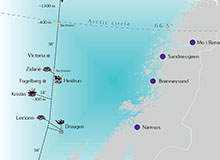
Polarled gas pipeline is a 480km-long pipeline laid between the Aasta Hansteen field in the Norwegian Sea and the Nyhamna gas processing facility in western Norway.
Laid in 1,260m of water at the Aasta Hansteen field, Polarled is the first pipeline to reach the Arctic Circle.
The project, which was earlier known as the Norwegian Sea Gas Infrastructure (NSGI) scheme, was proposed with an estimated investment of Nkr11.1bn ($1.3bn). Pipeline construction was completed in September 2015.
The project is being undertaken by a joint venture comprising Statoil (37.07%), Wintershall (13.25%), Petoro (11.94%), OMV (9.073%), Shell (9.019%), Total (5.110%), RWE Dea (4.791%), ConocoPhillips (4.452%), CapeOmega (2.88%) and Edison (2.396%).
Statoil transferred the operatorship of the pipeline to Gassco in May 2017.
Statoil submitted the plan for installation and operation of the natural gas pipeline on behalf of the partners to the Ministry of Petroleum and Energy in January 2013. The company also presented the plan for development of the Aasta Hansteen field at the same time.
The Polarled pipeline project aims to create gas transport infrastructure for discoveries already made in the Norwegian Sea and future discoveries. This will help in maintaining the Norwegian Continental Shelf’s role as a reliable gas supply source in the future.
Aasta Hansteen field and Polarled pipeline development project
Aasta Hansteen field is located in the Norwegian North Sea. Field development includes the installation of a SPAR platform tied-in with the Polarled gas pipeline. The field is estimated to contain 47 billion cubic metres of gas.
The Polarled pipeline has a diameter of 36in. It has a capacity of 70 million cubic metres per day.
The development of the pipeline comprises the installation of five in-line tee structures, including one double tee, laydown with pipeline collar connector at Aasta Hansteen platform and installation of a 2km-long vent line at Aasta Hansteen.
The project also included the expansion and upgrade of the Nyhamna processing plant, which is located 5m from the existing UK-based Langeled gas export pipeline.
The field started production at a rate of 130,000 barrels of oil equivalent per day in December 2018.
Design of the Polarled natural gas pipeline
The Polarled pipeline starts from the Aasta Hansteen field. The pipeline is laid approximately 300km west of Bodo. Construction of the pipeline required 325,000t of steel pipes worth Nkr2bn ($347m), including pipes, bends and buckle arrestors. Each pipe measures 12.2m.
The project also included a 30km-long, 18in diameter spur to the Kristin platform, which connects the pipeline to the Asgard Transport system. Tie-ins to the Linnorm discovery through Draugen field and to the Zidane field through Heidrun discovery, as well as 60km and 173km spurs, are also part of the plan.
Polarled gas pipeline route and construction
The route of the pipeline falls in the strait of Bjornsundet and along existing subsea pipelines. Selection of the route, therefore, required specialised design. The route follows the contours of the strait and crosses the Polar circle. The route selection also required optimisation of pipeline wall thickness and design of the buckle arrestor.
Pipeline passes through rough and uneven terrains consisting of ancient icebergs, which necessitate the use of long free spans with rock support. Deepwater seabed installation equipment was used for construction of the pipeline.
Contractors
Ramboll was responsible for carrying out the front end engineering and design (FEED) study for the project. The company also conducted quantitative risk analysis and preparation of the environmental impact assessment as well as received the contract for the detailed design of the pipeline. Nemo was the subcontractor for the FEED study.
In February 2013, Statoil awarded three contracts worth NOK 4bn ($694m) to three companies. Marubeni Itochu/JFE was awarded a fabrication contract worth NOK 2.4bn ($416m), which includes an option for the spur line to the Kristin platform.
The second company was Wasco, which was awarded the coating contract worth NOK 1.2bn ($208m). The scope of the contract includes the construction of a new production facility in Mo i Rana in northern Norway. Wasco utilised a number of local subcontractors in Norway for applying concrete coating for pipeline at the new facility.
Allseas won the NOK 750m ($130m) contract for pipelaying work. It used Solitaire, the world’s largest pipelaying vessel, for the task. BASF Polyurethanes provided polyurethane elastomer. Aibel received an Nkr200m ($32.4m) contract to connect Kristin platform with Polarled pipeline in December 2013.
FO> received a contract for quality check and supply of high integrity connectors for the pipeline in June 2013. Kongsberg Oil & Gas Technologies received an Nkr380m ($64.6m) contract for delivering subsea structures, in-line tees, tie-in and related connection system for the project in August 2013.
DNV GL won pipelay surveillance contract for the project in May 2015.



